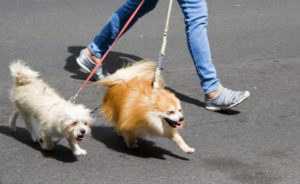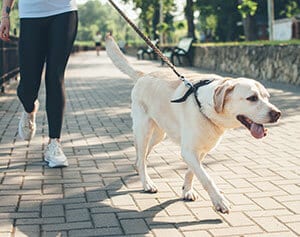It’s no secret that every breed of dog is different and has their own traits, needs, and personality. Even dogs of the same breed can vary widely in their energy levels and need for exercise.
Walks are an important part of your dog’s development and wellbeing. You may find yourself walking your dog five times a day or only once or twice a day and may be asking yourself “how often should I be walking my dog each day?”

Types of Dogs and Their Walk Times
Smaller Breeds
Smaller breeds and older dogs may only need to be walked once per day. Their energy levels are typically lower than puppies and larger, working dogs. Their lower amounts of stamina mean shorter walks. A quick trip around the block, twice a day, could be beneficial for both you and your pet.
Puppies
Puppies typically need to be let out every two hours. Frequent bathroom breaks are helpful for potty training and can spend some of that endless energy all puppies seem to have. Although they need to go out much more, puppies do not need to be taken on long walks. As your puppy grows, add five minutes to your walk each month. You can walk your puppy twice a day to be sure you are not overworking them. Overworking your puppies can cause damage to joints that could eventually lead to arthritis and other issues that could make mobility a challenge.
High-Energy Dogs
High-energy dogs such as Border Collies, Siberian Huskies, Labrador Retrievers, and many Terrier breeds are the perfect companions for long hikes, runs, and walks. Their energy levels require a lot more outdoor time than most other breeds. Three 15-minute walks a day or two 20 to 30-minute walks should be sufficient exercise. If your high-energy dog seems to have extra energy at the end of the day, try taking them out for one more walk before bed.
Working Dogs
Working dogs, like Sheepdogs and Cattle Dogs, need the most outdoor time. These dogs are high energy and very intelligent. A lack of exercise and stimulation can lead to boredom which, in turn, can lead to behavioral problems. At minimum, they need four 20-minute walks each day unless they have access to a yard or field for supervised outdoor time.
Hunting Dogs
Hunting dogs are similar to working dogs in that they have high energy and need to have a purpose or job. Three walks a day for a minimum of 30 minutes is recommended. This means that these dogs are also good hiking and running buddies.
Overweight Dogs
While walks are a beneficial way to exercise overweight dogs, be sure not to exacerbate any heart or joint issues. Overweight dogs who do not suffer from any additional side effects can handle up to 30 minutes of brisk walking a day. If your dog struggles on walks, start gradually and add 5 minutes every time you walk to build up its endurance.
Not Sure, Ask Your Vet
If you aren’t sure what breed your dog is or if they can handle the amount of exercise recommended for their breed, consult our veterinarians. You can also observe your dog while you walk, if they start panting excessively or slowing down, you should turn around and head back. You can slowly build up your dog’s tolerance for walks by adding more time to each walk and paying attention to their physical cues.
Don’t Use a Retractable Leash
Retractable leashes are popular among dog owners, but we strongly recommend against using them for several reasons. First, retractable leashes give you less control over your dog; the leads can be as long as 26 feet and because you can’t wrap the leash around your hand, you’re more at risk of dropping it if your dog pulls too hard.
Another problem is that these leashes allow your dog to get far enough away from you to cause trouble, whether that involves running into the street, eating something they shouldn’t, or approaching another dog or person. Additionally, the leash cord can snap more easily, since it’s attached to a mechanism in the plastic handle–not your hand.
Retractable leashes can cause injury to humans and dogs alike if they get tangled in the cord or if the leash retracts suddenly. Finally, another big problem with retractable leashes is that they can encourage dogs to pull more during walks–because when they pull, the length of the lead extends, giving them more room to roam.
 The Time of Year Can Affect Your Walk Times
The Time of Year Can Affect Your Walk Times
When walking your dog in extreme weather, either during the winter, summer, or in the rain, be sure to protect them from the heat, cold, and wet conditions. Like humans, dogs can be impacted by weather conditions. When the ground freezes or heats up, your dog’s paws are vulnerable. You might have to shorten your walks, properly time your walks, or split them up into smaller distances throughout the day.
In summer months, plan your walks around the temperature. Walking your pet first thing in the morning and just after sundown can protect them from the heat. Be sure to bring water and move slowly, adjusting to your dog’s needs. To test if the pavement is too hot for your dog’s paws, place the back of your hand on the ground for 10 seconds, if it feels too hot, avoid walking on pavement or invest in some boots or paw protectors.
In winter months, be sure to plan your walks about freezing temperatures. Windchill and a below freezing “feels-like” temperature can be dangerous for you and your dog. If your dog is shivering, it may be time to put on a coat or cut the walk short. Dogs’ paws are also sensitive, you need to keep their paw hairs trimmed short so they cannot pick up any ice or snow and might need to invest in dog snow boots if you live in an area that has frequent snowfall. As always, pay attention to your dog’s body language to know how long to walk them in cold weather.
While not as physically demanding as walking your dog in the heat or snow, walking your dog in the rain can also be a challenge. Both you and your dog should wear reflective gear to be seen by motorists. Be sure to avoid letting your dog drink from puddles along the walk, they can carry bacteria and dirt that could make your pet sick. Shorten your walk and when you arrive home, be sure to completely dry off your dog’s paws. Wet paws can lead to fungus and can also cause your dog to slip and slide on any hard surfaces.
Now That You Know Dog Walking in Schertz, TX Varies
No matter what breed your dog is, walks in Schertz, TX can be beneficial to you and your dog. On-leash allow dogs to get a better grasp on discipline and learn to follow your lead. Walks can also keep your dogs entertained, preventing them from partaking in destructive behavior at home.
Not only are walks a great, low-impact way to keep active, they also help you and your dog bond. Harvard recommends walking 20-30 minutes each day, why not spend that time with your dog?
Recent Posts
About Us
We know that choosing the right veterinarian for your pet (and you) can be a challenge. Yet, with our stress-free handling, our long-term, experienced staff, and a state-of-the-art facility, we make the decision an easy one!
